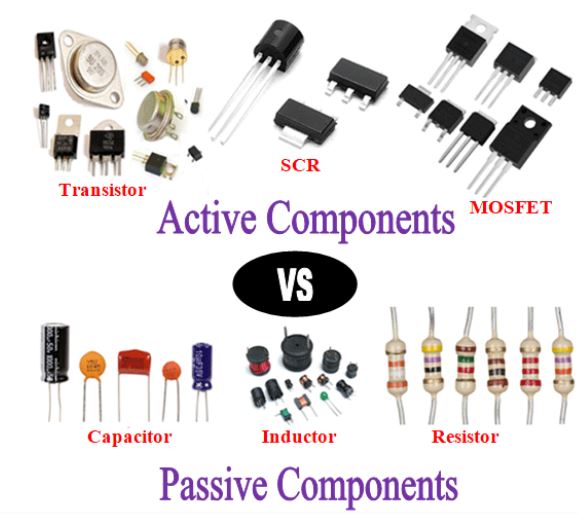All Electronic components can be broadly classified into two classes, namely Active Components and Passive components. These components are diametrically different from each other based on their functional properties and operation. In this article, we will learn about the different types of active and passive components and will also look into the difference between active and passive devices. But, before understanding how different they are from each other, it is important to understand what each component means and how they work, so let’s get started with active components.

The Two Types of Electronic Devices
Electronic elements that make up a circuit are connected together by conductors to form a complete circuit.
- Active components
- Passive components

What are Active Components?
Active components are devices that can amplify an electric signal and produce power. Any characteristic active component will comprise an oscillator, transistor or an integrated circuit. An active component functions as an alternating current circuit in devices. This helps the device to augment power and voltage. This component can execute its operations because it is powered by a source of electricity. All active components necessitate some source of energy which commonly is extracted from a DC circuit.
Active Components
An active component is an electronic component which supplies energy to a circuit.
Common examples of active components include:
- Voltage sources
- Current sources
- Generators (such as alternators and DC generators)
- All different types of transistors (such as bipolar junction transistors, MOSFETS, FETs, and JFET)
- Diodes (such as Zener diodes, photodiodes, Schottky diodes, and LEDs)
Voltage Sources
A voltage source is an example of an active component in a circuit. When current leaves from the positive terminal of the voltage source, energy is being supplied to the circuit. As per the definition of an active element, a battery can also be considered as an active element, as it continuously delivers energy to the circuit during discharging.
Current Sources
A current source is also considered an active component. The current supplied to the circuit by an ideal current source is independent of circuit voltage. As a current source is controlling the flow of charge in a circuit, it is classified as an active element.
Transistors
Although not as obvious as a current or voltage source – transistors are also an active circuit component. This is because transistors are able to amplify the power of a signal (see our article on transisors as an amplifier if you want to know exactly how).
Passive Components
A passive component is an electronic component which can only receive energy, which it can either dissipate, absorb or store it in an electric field or a magnetic field. Passive elements do not need any form of electrical power to operate.
As the name ‘passive’ suggests – passive devices do not provide gain or amplification. Passive components cannot amplify, oscillate, or generate an electrical signal.
Common examples of passive components include:
- Resistors
- Capacitors
- Inductors
- Transformers
Resistors
A resistor is taken as a passive element since it can not deliver any energy to a circuit. Instead resistors can only receive energy which they can dissipate as heat as long as current flows through it.
Inductors
An inductor is also considered as passive element of circuit, because it can store energy in it as a magnetic field, and can deliver that energy to the circuit, but not in continuous basis. The energy absorbing and delivering capacity of an inductor is limited and transient in nature. That is why an inductor is taken as a passive element of a circuit.
Capacitors
A capacitor is considered as a passive element because it can store energy in it as electricfield. The energy dealing capacity of a capacitor is limited and transient – it is not actually supplying energy, it is storing it for later use.
As such it is not considered an active component since no energy is being supplied or amplified.
Transformers
A transformer is also a passive electronic component. Although this can seem surprising since transformers are often used to raise voltage levels – remember that power is kept constant.
When transformers step up (or step down) voltage, power and energy remain the same on the primary and secondary side. As energy is not actually being amplified – a transformer is classified as a passive element.
Differences between Active and passive components
Now that we have understood about the Active and Passive devices and its types, let us do a comparison between active and passive components based on certain parameters as defined below
1) Source of energy – Active components require an extra source of energy. In the case of passive components, no extra source of energy is required for their operation. A resistor works on its own without the need for a specific voltage.
2) Energy: Active components produce energy in the form of voltage or current but passive components are those devices that store energy, like a capacitor, stores its energy in form of electric field and an inductor stores its energy in form of a magnetic field.
3) Linearity: Passive components are linear and active components are non-linear. Meaning in a passive component like a resistor, the voltage drop across will be linear to its resistance value according to Ohms Law. While in a transistor or other active components the output will have an amplification factor that will not be linear.
4) Power gain: Active components are capable of providing power gain whereas in the case of passive components the ability to amplify power is not present.
5) Controlling the current: Active component as the name implies can easily control the flow of the current. The same task cannot be done by a passive component.
6) External source: Active components as seen earlier require an extra source to control and maintain its operations but in the case of passive components, there is no requirement of an external source.